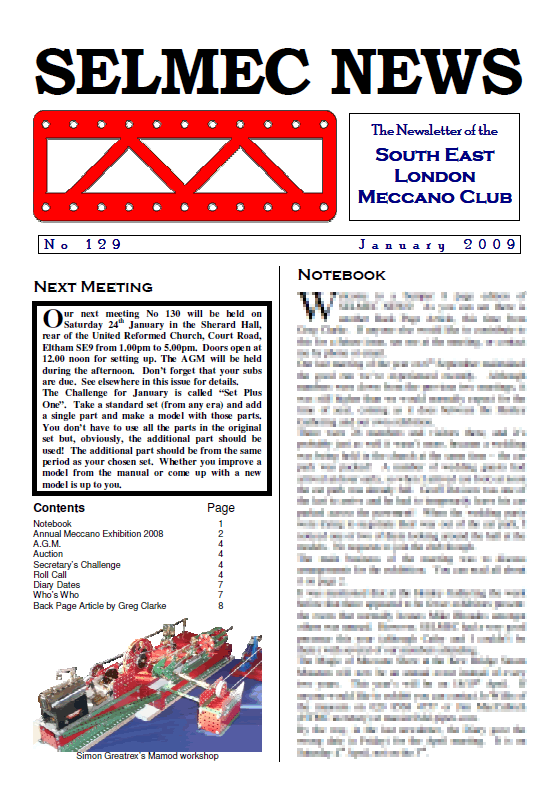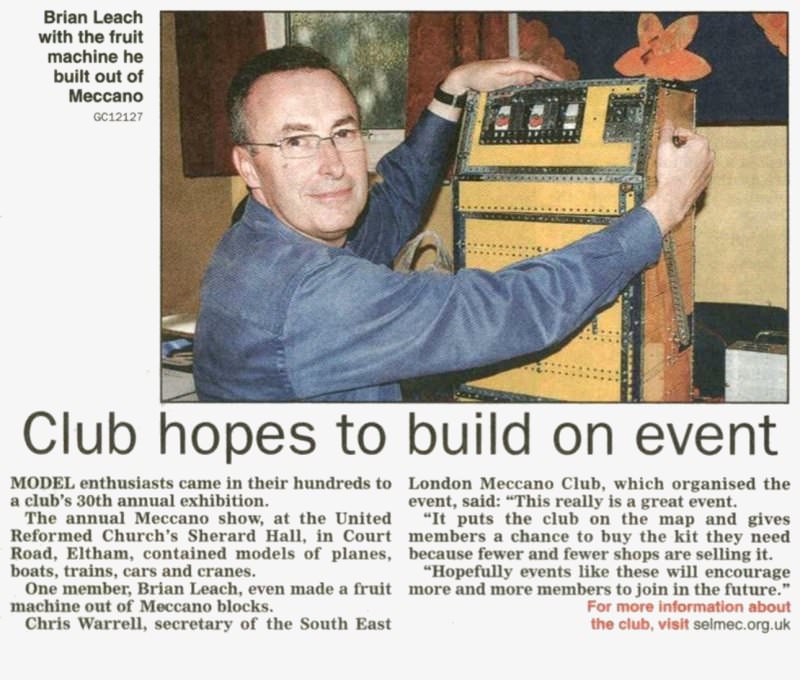January 2009 Newsletter

January 2009 Newsletter
Issue 129
This was one of our informal quarterly meetings where our members showed off their latest Meccano creations.
At around 2:00pm we had a short committee meeting, followed by the Model Tour in which members were invited to give a short talk about their models — in particular their entries for the Secretary’s Challenge!
Report written by Chris Warrell
A fine sunny day greeted us as we assembled outside the hall on 11th October. Cathy and I arrived at about 7:40am to find another half dozen members already there and ready to unload. All this activity brought John out of his flat above us, so he opened the hall earlier than the booked time of eight o’clock.
It wasn’t long before we’d arranged the tables into the usual layout, although exactly how we decide which table goes where seems to vary from year to year. There was some last minute re-shuffling when Keith Patey brought a couple of sturdy folding tables. One was used on the end of the island in the main hall, and the other put in the room with the refreshments. This was added to John Gay’s table (he’d brought his own), so this gave us an additional run of tables opposite the refreshment counter. John was very pleased with that location; visitors who’d been chatting to him about his models would frequently offer him a cup of tea! A small table was put in the lobby for a windmill complete with coloured lights to entice the visitors in.
Luckily everyone fitted in to the space provided without too much shuffling around. Altogether we had 26 exhibitors, plus Dave Taylor with his usual Aladdin’s cave of sets and spares. We had two visiting exhibitors; Dick Watson of the North West Meccano Guild, making his third or fourth appearance, and lone enthusiast Stuart Jones from Uckfield who enjoyed the experience so much that he decided to join us!
The attendance was noticeably improved from 2007 — we sold 114 adult tickets plus 48 children/OAP tickets. If you add on, say, 57 for the accompanied children (who came in for nothing, but didn’t get a ticket, so we’ve no accurate figure) that makes a total of around 219. That’s about a hundred more than last year! Quite why the big improvement I don’t know; it was probably a combination of things: flyers left at a model railway exhibition in Bexley; the free advert in the Railway Modeller; and, of course, the Old Bexley Primary School Summer Fair in July.
The News Shopper newspaper sent a photographer and the picture below of Brian Leach with his fruit machine appeared in it a couple of weeks later. They actually conducted the interview with me over the phone before the event and my quotation, of course, can be taken with a pinch of salt! They got the gist of it right, though.

News Shopper article
Members may remember that our webmaster Tim Surtell was filming models along with commentaries from various exhibitors during the day. This has all been edited and he’s done an excellent job.
Watch our video of the exhibition
Thanks are due to everyone who helped with setting the hall up, tying up posters in the High Street, clearing everything away at the end and everyone who manned the various rotas. Special thanks, of course, to Cathy and Rose Warrell who did a great job serving the refreshments. We’re also grateful to members who provided the food and drink.
Models on Display
Jim Arthur — Clock; Various vehicles.
Adrian Ashford — Two marine engines; Liner; Archimedean ball roller; Bus; Fireless locomotive; Two or three smaller models.
Geoff Carter — 15 models: Two cranes: 1970s set ‘Contractors Crane’, in yellow, blue and zinc; 1934–1954 (?) 4-set crane; Two High Street models: Last year’s Sopwith Camel (M&S) and this year’s VW Beetle (Argos); Two more set models: The Renault F1 car and the ‘Landmarks’ Eiffel Tower; Two models from issues of Constructor Quarterly: John Herdman’s Rolls Royce Silver Ghost and John Lavers small Starship Enterprise. The other seven were designed by Bernard Périer: Three from Constructor Quarterly - Two articulated Tankers (1/40 and 1/80th scales approximately) and the Boeing Vertol ‘Sea Knight’ twin rotor helicopter, roughly 1/87 scale. The other four models are from Bernard’s Zkwyx Meccanaut book — Zorida, the cybernetic spider, Archie, the caterpillar, Tumbler and the Robot Butler.
Greg Clarke — Liebherr LTM 1220 220 Ton Mobile Road Crane.
Peter Clay — Clockwork tractor; Potato reaper; Grass mower; Meccanograph; Butcher’s wagon; Sports car; Caterpillar tractor; Woodpecker; M&S tractor; Chess set and Meccano pen holder.
Andrew Couzens — Lorry mounted crane; 4–6–0 steam locomotive and tender; Articulated low loader (1960s № 6 manual); Saloon car (1960s № 3 manual).
John Cowdery — Lion engine; Blaw Knox compactor; Robot; Other models.
Ivor Ellard — A diorama of the Total Energy Plant with viaduct and clockwork train – a windmill powers a pump which feeds a refinery; heavy oil runs the boiler which powers a Watt beam engine which turns a generator.
Brian Elvidge — 1997 Master Connection Set abyss visitor; Traction engine; Miniature Peterbilt lorry and trailers; Motorised articulated lorry.
George Foard — Four or five amusement models.
Chris Fry — Girderscope Mk 3 (mechanical kaleidoscope); Piper Cub aeroplane; Triumph TR3A sports car; MIG 21 jet fighter; 1920s racing car; Double-acting ratchet mechanism.
Simon Greatrex — Mamod workshop powered by a horizontal steam engine.
John Gay — Octopus fun fair ride with Foden lorry in red/green.
Cathy Claydon — Armoured personnel carrier; Half track truck with searchlight; Mobile anti-aircraft gun (all from the Army Multikit set).
Stuart Jones — Double flyboats from 1920/30s Super Models series (SML 33) powered by E20 motor plus lights; Traction engine7½” long from a prize-winning (Model Engineer Exhibition 1970) design by Bert Halliday.
Ralph Laughton — Funicular railway.
Brian Leach — Fruit machine, partly constructed.
Frank Paine — Single-cylinder double-acting mill engine and big wheel (both push button operated); Stephenson’s Rocket shop display model; Hoisting crane incorporating a twin cylinder Mamod engine; Tower Bridge shop display model; ‘Schools’ class locomotive (push button operated); Emmett style loco and wagons; Traction engine (push button operated); Small beam engine; Windmill; Car chassis based on the Super Model leaflet; Several vintage sets from 1916 to the 1960s.
Keith Patey — Bagatelle game; Climbing monkeys.
Santiago Plicio — ‘The Vortex’ fairground ride.
Chris Smith — Twin cylinder steam engine (Super Models Leaflet 32).
Eric Smith — Rapier mobile crane; Grove all-purpose mobile crane; Travelling crane.
Tim Surtell — Teacher and weightlifter; Meccano on the Internet presentation.
Chris Warrell — Steam powered pit head gear; Blue/gold crane; Three cars.
Dick Watson — John the Navvy (Bernard Périer model); Victorian optical device (he can’t remember the name) driven by a synchronous motor; Another Périer model; Bizarre building in Liverpool; Man-powered monorail car; Small beam engine.
Alan Wenbourne — Dive bomber fairground ride; Rolling bridge.
Douglas Windibank — Various models.
Written by Greg Clarke
The Prototype
The LTM 1220 is a 5-axle medium to heavy size road crane with a transport weight of 60 tons and length of 15.5m. Its carrier engine is a six-cylinder 503hp diesel and the crane engine is a 4-cylinder 245hp diesel. The crane fitted with its maximum of 74 tons of ballast can lift 220 tons at a radius of 6 metres but a far more useful lift is 36 tons at 18 metres using 50 metres of its extension capability.
All lift functions are monitored by its own on-board computer called LICCON. This system prevents dangerous lifts by locking out the crane if it’s going to exceed its lift parameters like high winds/uneven stabilising etc.
The Model
This is the second example of current Liebherr produced cranes I have built, the first being the 300 ton lattice boom crane I made in 2008. For this model I wanted to try several new build techniques and take it to the next level.
Watch our video of this model
The model is roughly 1:17 scale with the carrier assembly 750mm long and the height of the boom fully extended at maximum elevation 1350mm. The model took about 150 hours to build over a one year period. It’s made in 1970s yellow, zinc and blue which in my opinion is definitely the best colour for modern day plant. The crane is based on three main sub-assemblies: the carrier; crane body and boom.
The carrier chassis is made from 4 x 24½” double angle girders with 2½” girders as cross-members. The wheels are the 2¾" diameter rubber type which give the right width but are a little undersize for scale. Rather than attempting to create drive I concentrated on suspension and steering. The suspension is independent for each wheel and is based on a parallelogram design using narrow 4-hole strips and 2” rods as link bars. The springs were the very nicely made 1½” compression spring units from Stewart Borrill. The cab features windscreen wipers, headlights and side mirrors and can be removed to get to the stabiliser motor.
The stabilisers are made from 5½” double angle strips running out on a 4½” x 2½” plate using ½” plastic rollers as guides. All the arms extend and retract together using a push/pull arrangement with cord. An M5 motor geared down turns the forward cord shaft and a PTO takes the drive to the rear. After slewing the crane body two panels at the rear can be lifted to show the drive mechanism. The turntable is made up using ball bearings sandwiched between 4” circular plates and 5½” circular strips. The drive for this is also located in the carrier assembly.
I tried to model as much as possible in Meccano but one area where I deviated was the luffing ram which lifts the boom. I had see several examples from other builders using various techniques with cord, pulleys and threaded rod but all these methods lacked the prototypes single large ram with a chrome rod taking all the strain.
Taking the idea from Tony James JCB Loadall, I used a ¾" chrome towel rail for the piston rod but there the similarity ended. The pulley cord system Tony used clearly was not going to be man enough for this job so I built a mock-up and experimented with various screwed rod drives until I settled for M6 size. With a ¾" thrust bearing taking the vertical load the whole boom is elevated by rotating the rod which in turn drives a special M6 threaded coupling attached to the bottom of the chrome rail. A ¾" hydraulic dowty seal provides a very realistic cylinder seal and journal. An MO motor/gearbox linked to a 3:1 bevel gear provide the drive. Externally the crane body features a tilting cab, side ladders, folding safety handrails, removable dummy counterweights and exhaust muffler for both the carrier and crane engines.
The boom was originally going to be in three segments but the load proved to be too high for the luffing ram to lift so I settled for two. This is made up from 49-hole girders for the primary and 37-hole for the secondary which run very smoothly on a bearing of plastic collars. The hook is a double sheave design with the hook free to rotate and swivel like the prototype.
Thanks to Brian Maunder for feeding me a regular supply of parts and Stewart Borrill and Dave Taylor for some of the more unusual pieces. Can’t wait to start the next one!